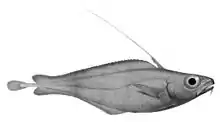| North Atlantic codling | |
|---|---|
 | |
| Illustration from Report on the deep-sea fishes collected by H.M.S. Challenger during the years 1873–1876 | |
| Scientific classification | |
| Domain: | Eukaryota |
| Kingdom: | Animalia |
| Phylum: | Chordata |
| Class: | Actinopterygii |
| Order: | Gadiformes |
| Family: | Moridae |
| Genus: | Lepidion |
| Species: | L. eques |
| Binomial name | |
| Lepidion eques (Günther, 1887) | |
| Synonyms[2] | |
| |
The morid cod, largeye lepidion, or North Atlantic codling (Lepidion eques) is a species of fish in the family Moridae.[1][3][4] The Catalog of Fishes considers it a synonym of Lepidion lepidion.[5]
Name
The specific name eques means "knight", referring to the plume-like protuberance on its head; this is also reflected in the Icelandic name bláriddari and Danish name blå ridder, both meaning "blue knight."[6]
Description
_(20211931363).jpg.webp)
The North Atlantic codling is pink-brown in colour with a blue tinge; albinos are common.[7] It is up to 44 cm (1.44 ft) in length.[8] Its posterior nostril is immediately anterior to the eye. There are 55–60 dorsal finrays and 50–54 anal finrays. It has a lateral line with pit organs but no pores, and 8–13 pyloric caeca.[9]
Habitat
The North Atlantic codling lives in the North Atlantic Ocean; it is benthopelagic, living at depths of 120–1,900 m (390–6,230 ft).[1][3][10][11][12]
Behaviour
The North Atlantic codling feeds on crustaceans and polychaetes.[2] It usually swims close to sandy bottoms and exhibits station holding behavior.[13][14]
References
- 1 2 3 Iwamoto, T.; Gordon, J.D.M. (2017) [errata version of 2010 assessment]. "Lepidion eques". IUCN Red List of Threatened Species. 2010: e.T154838A115240650. doi:10.2305/IUCN.UK.2010-4.RLTS.T154838A4647340.en. Retrieved 16 June 2023.
- 1 2 "Lepidion eques (Günther, 1887)". WoRMS. World Register of Marine Species.
- 1 2 Froese, Rainer; Pauly, Daniel (eds.) (2023). "Lepidion eques" in FishBase. February 2023 version.
- ↑ "Technical Report - Fisheries Research Board of Canada". Fisheries Research Board of Canada. July 30, 1969 – via Google Books.
- ↑ Eschmeyer, William N.; Fricke, Ron & van der Laan, Richard (eds.). "Haloporphyrus eques". Catalog of Fishes. California Academy of Sciences. Retrieved 16 June 2023.
- ↑ "North Atlantic codling - Lepidion eques - (Günther, 1887)". eunis.eea.europa.eu.
- ↑ Goode, George Brown (July 30, 1895). "Oceanic Ichthyology: A Treatise on the Deep-sea and Pelagic Fishes of the World, Based Chiefly Upon the Collections Made by the Steamers Blake, Albatross, and Fish Hawk in the Northwestern Atlantic, with an Atlas Containing 417 Figures". U.S. Government Printing Office – via Google Books.
- ↑ "Lepidion eques : North Atlantic Codling | NBN Atlas". species.nbnatlas.org.
- ↑ "Marine Species Identification Portal : Lepidion eques". species-identification.org.
- ↑ Shotton, Ross (July 30, 2006). Deep Sea 2003: Conference reports. Food & Agriculture Org. ISBN 9789251054024 – via Google Books.
- ↑ "Lepidion eques (Günther, 1887)". Global Biodiversity Information Facility.
- ↑ "Lepidion eques (North Atlantic codling)". descna.com.
- ↑ Söffker, M.; Sloman, K.A.; Hall-Spencer, J.M. (2011). "In situ observations of fish associated with coral reefs off Ireland". Deep Sea Research Part I: Oceanographic Research Papers. 58 (8): 818–825. Bibcode:2011DSRI...58..818S. doi:10.1016/j.dsr.2011.06.002. hdl:10026.1/1329.
- ↑ Magnússon, Jutta V. (May 2001). "Distribution and some other biological parameters of two morid species Lepidion eques (Gunther, 1887) and Antimora rostrata (Gunther, 1878) in Icelandic waters". Fisheries Research. Deep-Water Fish and Fisheries: a Selection of Papers Presented at the ICES Annual Science Conference in Lisbon, Portugal 16-18 September 1998. 51 (2): 267–281. doi:10.1016/S0165-7836(01)00251-X.
